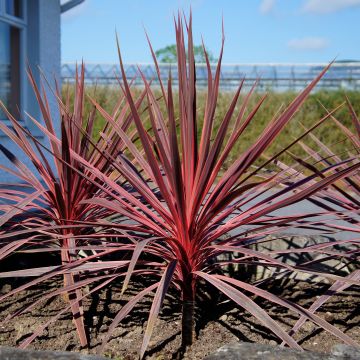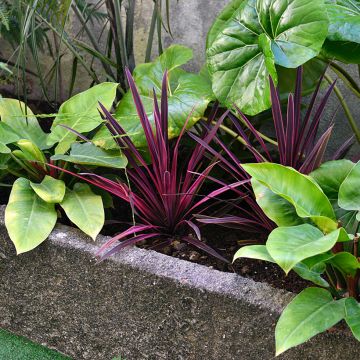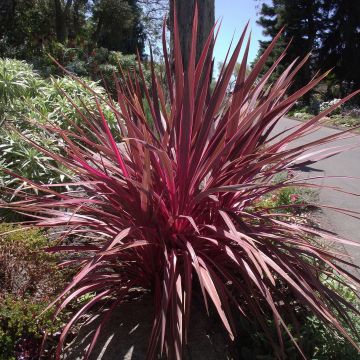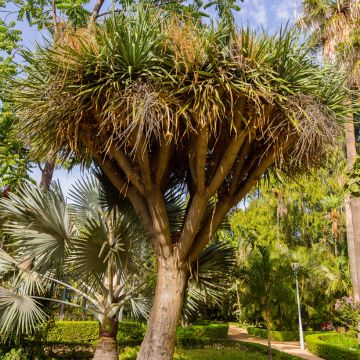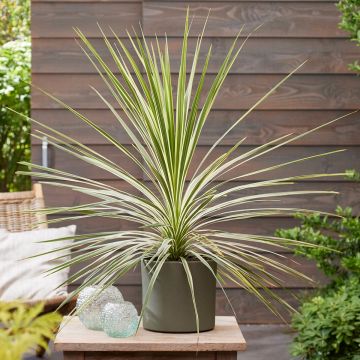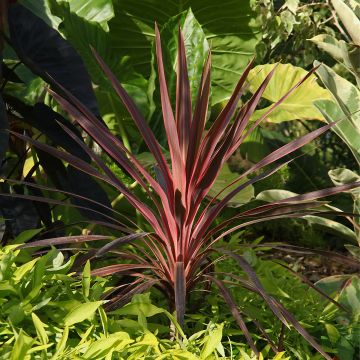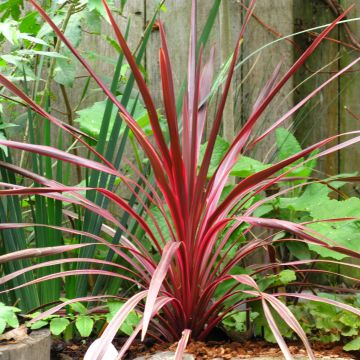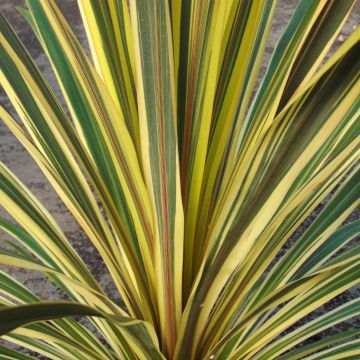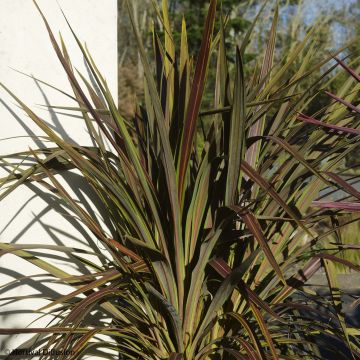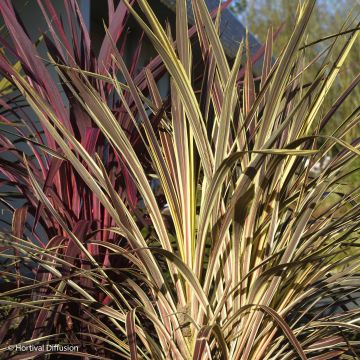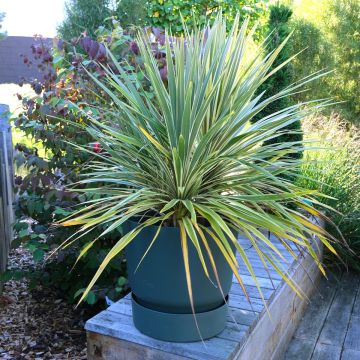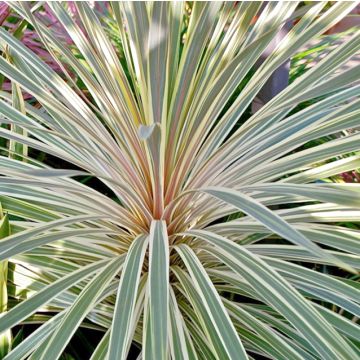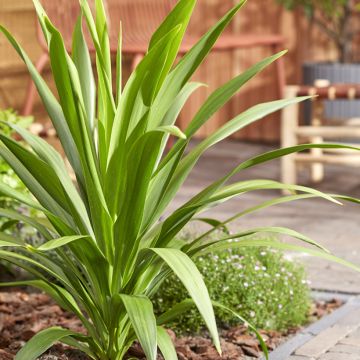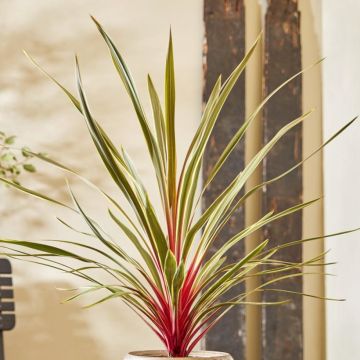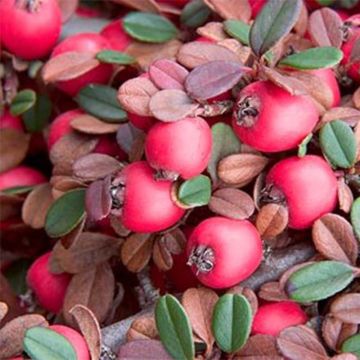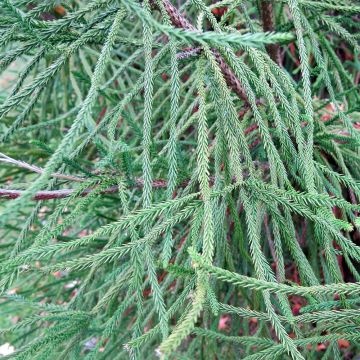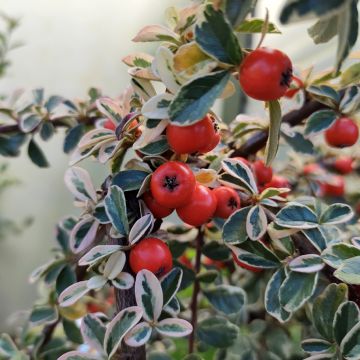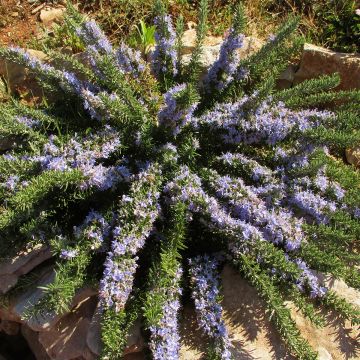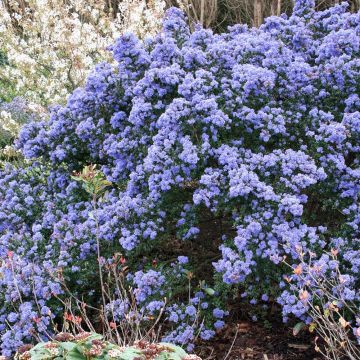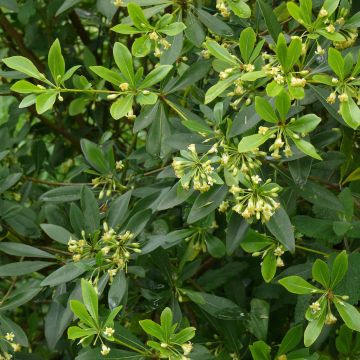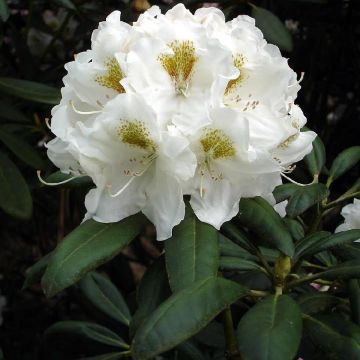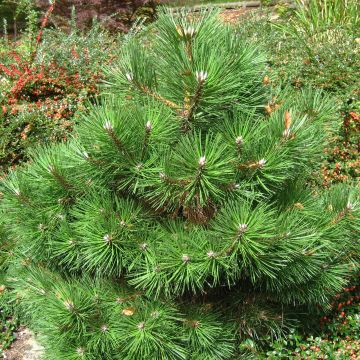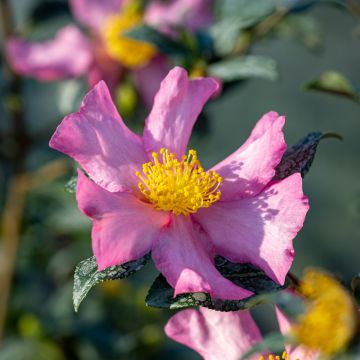

Cordyline Tana
Cordyline Tana
Cordyline x banksii 'Tana' RENEGADE ( DESIGNLINE series )
Forest Cabbage Tree
Why not try an alternative variety in stock?
View all →This plant carries a 24 months recovery warranty
More information
We guarantee the quality of our plants for a full growing cycle, and will replace at our expense any plant that fails to recover under normal climatic and planting conditions.
From €5.90 for pickup delivery and €6.90 for home delivery
Express home delivery from €8.90.
Does this plant fit my garden?
Set up your Plantfit profile →
Description
Cordyline Tana or 'Renegade' is a variety of hybrid cordyline with very dark foliage! This trunkless bush strongly resembles a Phormium with its ribbon-like, arched leaves gathered in a clump. Their colour ranges from dark purple-red to black, passing through chocolate brown. It is compact, not exceeding 1 to 1.5 m in height and 50 to 80 cm in width. It is suitable for small gardens, coastal gardens and on a terrace, in a large pot. From May to July, long spikes of small cream-white flowers with a slight fragrance appear. It is a tender plant to be grown in pots in colder regions. Requiring little care, it tolerates salt spray, heat, and drought, although it prefers moist, well-drained soil.
From the Agavaceae family, Cordyline x banksii is a perennial tree-like plant native to New Zealand. In nature, this upright and bushy shrub can reach a height of 3 to 4 m. Its trunk branches little and does not become bare. The Banks' cordyline is particularly found on the coast and in low-altitude mountains, suggesting its great adaptability to varied conditions such as salt spray, heat, and drought. The Tana or 'Renegade' variety is a horticultural creation by Evan David Lloyd from 2006 in New Zealand. It is part of a series of cultivars known as Designline. It remains compact and forms a clump about 1 m high and 50 cm wide, sometimes a little more. Its evergreen leaves are long and narrow, sword-shaped, pointed and slightly arched. Their colour is intense and dark, almost black. Flowering occurs from May to July on mature plants. The flower stalk bends under the weight of numerous small cream-white, nectar-rich and delicately scented flowers.
Resistant to wind and salt spray, it is the ideal plant for coastal areas. Cordyline 'Renegade' can be planted in the middle of a flowerbed, in a pot on a balcony or terrace, or as a standalone feature on a lawn in a small garden. In a flowerbed with exotic accents, pair it with a red Abyssinian banana tree with lush purple-tinged foliage and add colour with the red flowers of Canna 'Red Wine' and Crocosmia 'Lucifer'. In a container, create contrast by opting for Delosperma Wheels of Wonder 'Hot Pink' with its spreading habit and fluorescent pink flowers.
Report an error about the product description
Plant habit
Flowering
Foliage
Botanical data
Cordyline
x banksii
'Tana' RENEGADE ( DESIGNLINE series )
Asparagaceae
Forest Cabbage Tree
Cordyline x banksii 'Renegade', Cordyline x banksii 'Tana' RENEGADE
Cultivar or hybrid
Other Cordyline
Planting and care
Cordyline 'Tana' thrives in full sun or partial shade in rich, moist, and well-drained soil. It hates waterlogged soils. Ideal for coastal areas, it tolerates wind and sea spray, but whenever possible, shelter it from cold north winds. It withstands high summer temperatures and drought once established. When planting in spring, add sand to promote soil drainage. Hardy down to -6°C, or even -8°C in sheltered locations, it may be necessary to protect the top of the bush with a winter cover. In cold climates, grow it in a pot so you can shelter it during winter. The Cordyline does not require any particular pruning. Just remove dried leaves at the end of winter and faded flowers. Do not overwater, only water in case of prolonged drought.
Planting period
Intended location
Care
This item has not been reviewed yet - be the first to leave a review about it.
Evergreen shrubs
Haven't found what you were looking for?
Hardiness is the lowest winter temperature a plant can endure without suffering serious damage or even dying. However, hardiness is affected by location (a sheltered area, such as a patio), protection (winter cover) and soil type (hardiness is improved by well-drained soil).

Photo Sharing Terms & Conditions
In order to encourage gardeners to interact and share their experiences, Promesse de fleurs offers various media enabling content to be uploaded onto its Site - in particular via the ‘Photo sharing’ module.
The User agrees to refrain from:
- Posting any content that is illegal, prejudicial, insulting, racist, inciteful to hatred, revisionist, contrary to public decency, that infringes on privacy or on the privacy rights of third parties, in particular the publicity rights of persons and goods, intellectual property rights, or the right to privacy.
- Submitting content on behalf of a third party;
- Impersonate the identity of a third party and/or publish any personal information about a third party;
In general, the User undertakes to refrain from any unethical behaviour.
All Content (in particular text, comments, files, images, photos, videos, creative works, etc.), which may be subject to property or intellectual property rights, image or other private rights, shall remain the property of the User, subject to the limited rights granted by the terms of the licence granted by Promesse de fleurs as stated below. Users are at liberty to publish or not to publish such Content on the Site, notably via the ‘Photo Sharing’ facility, and accept that this Content shall be made public and freely accessible, notably on the Internet.
Users further acknowledge, undertake to have ,and guarantee that they hold all necessary rights and permissions to publish such material on the Site, in particular with regard to the legislation in force pertaining to any privacy, property, intellectual property, image, or contractual rights, or rights of any other nature. By publishing such Content on the Site, Users acknowledge accepting full liability as publishers of the Content within the meaning of the law, and grant Promesse de fleurs, free of charge, an inclusive, worldwide licence for the said Content for the entire duration of its publication, including all reproduction, representation, up/downloading, displaying, performing, transmission, and storage rights.
Users also grant permission for their name to be linked to the Content and accept that this link may not always be made available.
By engaging in posting material, Users consent to their Content becoming automatically accessible on the Internet, in particular on other sites and/or blogs and/or web pages of the Promesse de fleurs site, including in particular social pages and the Promesse de fleurs catalogue.
Users may secure the removal of entrusted content free of charge by issuing a simple request via our contact form.
The flowering period indicated on our website applies to countries and regions located in USDA zone 8 (France, the United Kingdom, Ireland, the Netherlands, etc.)
It will vary according to where you live:
- In zones 9 to 10 (Italy, Spain, Greece, etc.), flowering will occur about 2 to 4 weeks earlier.
- In zones 6 to 7 (Germany, Poland, Slovenia, and lower mountainous regions), flowering will be delayed by 2 to 3 weeks.
- In zone 5 (Central Europe, Scandinavia), blooming will be delayed by 3 to 5 weeks.
In temperate climates, pruning of spring-flowering shrubs (forsythia, spireas, etc.) should be done just after flowering.
Pruning of summer-flowering shrubs (Indian Lilac, Perovskia, etc.) can be done in winter or spring.
In cold regions as well as with frost-sensitive plants, avoid pruning too early when severe frosts may still occur.
The planting period indicated on our website applies to countries and regions located in USDA zone 8 (France, United Kingdom, Ireland, Netherlands).
It will vary according to where you live:
- In Mediterranean zones (Marseille, Madrid, Milan, etc.), autumn and winter are the best planting periods.
- In continental zones (Strasbourg, Munich, Vienna, etc.), delay planting by 2 to 3 weeks in spring and bring it forward by 2 to 4 weeks in autumn.
- In mountainous regions (the Alps, Pyrenees, Carpathians, etc.), it is best to plant in late spring (May-June) or late summer (August-September).
The harvesting period indicated on our website applies to countries and regions in USDA zone 8 (France, England, Ireland, the Netherlands).
In colder areas (Scandinavia, Poland, Austria...) fruit and vegetable harvests are likely to be delayed by 3-4 weeks.
In warmer areas (Italy, Spain, Greece, etc.), harvesting will probably take place earlier, depending on weather conditions.
The sowing periods indicated on our website apply to countries and regions within USDA Zone 8 (France, UK, Ireland, Netherlands).
In colder areas (Scandinavia, Poland, Austria...), delay any outdoor sowing by 3-4 weeks, or sow under glass.
In warmer climes (Italy, Spain, Greece, etc.), bring outdoor sowing forward by a few weeks.

































